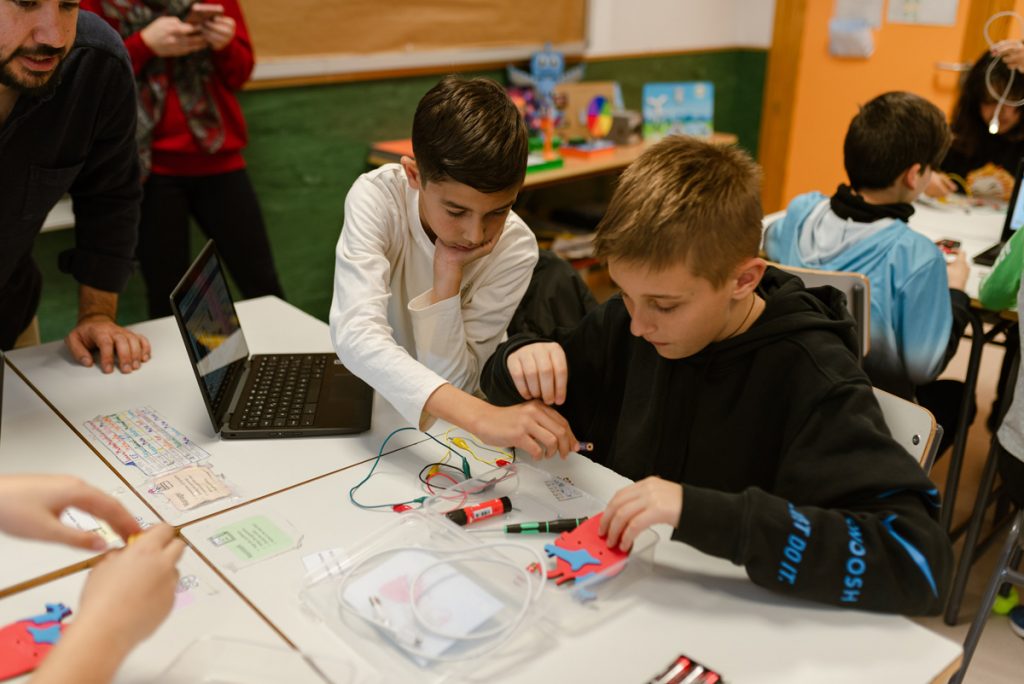Categories:
In recent years, classrooms have become spaces where interaction between humans and machines is increasingly common. These technological innovations have significantly altered the way we work in schools and the relationships among students, presenting us with the need to adapt to a constantly changing reality.
In this new context, digital literacy has become essential for success in contemporary society. It is not enough to have basic knowledge of technological tools; it is essential to develop advanced skills that enable us to fully understand and take advantage of the opportunities of the digital environment.
To face this educational challenge, it is crucial to incorporate computational thinking, programming, and robotics at all stages of the curriculum. Recognizing the importance of these competencies for the development of 21st-century skills, the Escuela 4.0 Code Program and its various initiatives are presented as a key initiative integrated into the Digitalization and Digital Skills Plan of the Education System.
This plan encompasses measures promoted by the Ministry of Education and Vocational Training. It aims to improve digital skills in the educational field, both in relation to student skills and the technological resources available and their effective implementation in teaching and learning processes. The main objective is to establish the necessary mechanisms and processes to facilitate the development of digital competencies related to computational thinking, programming, and robotics for teachers and students in public educational centers of the second cycle of early childhood, primary, and secondary education.
The specific objectives of the Escuela 4.0 Code program are:
- To enhance students’ digital skills, especially in computational thinking, programming, and robotics.
- To incorporate digital skills in the classroom, particularly in computational thinking, programming, and robotics, through teacher training, ongoing support, and the creation of digital educational resources.
- To provide educational centers with the necessary equipment to promote students’ digital skills, with a focus on computational thinking, programming, and robotics.
The main challenges facing the Autonomous Regions for the implementation of the project are:
- Teacher training: providing continuous and adequate training for teachers in digital skills, programming, and robotics, ensuring they are prepared to integrate these tools into their teaching methods.
- Curricular adaptation of resources: adjusting and updating educational resources to effectively incorporate digital skills, including programming, robotics, and computational thinking, at different educational stages in a simple and sequenced manner.
- Evaluation and monitoring: establishing evaluation and monitoring mechanisms to measure the progress and impact of the program, allowing for continuous adjustments and improvements. Additionally, it demonstrates the work done during the project’s implementation.
- Sustainability and continuous updating: developing strategies to keep the program updated in the face of rapid technological advances and changes in labor market demands, ensuring its long-term relevance and continuity of impact.
- Digital environment security: ensuring data protection, privacy, information security, and cloud service quality.
These challenges require a multifaceted and coordinated approach involving all stakeholders and adapting to the educational projects, equipment, and robotics journey of each Autonomous Region.
ODILO and Escuela 4.0
With the aim of facilitating the resolution of the challenges associated with the program’s implementation, ODILO proposes a comprehensive support service for the proper development of the Escuela 4.0 program. Our proposal consists of creating unlimited and personalized learning ecosystems tailored to the needs of each Autonomous Region, designed to promote education by accompanying, training, and supporting innovation.
ODILO Escuela 4.0 allows:
- Accompanying and training teachers.
- Promoting computational thinking and robotics in the classroom.
- Creating learning situations adapted to each educational stage.
Who is it for?
- To the teaching staff, both to continue their training and to implement this development in their face-to-face classes.
- To students, to develop learning situations and activities autonomously or semi-autonomously.
- To program companions and trainers, allowing them to create and share resources and learning situations.
How do we do it?
In parallel with support, ODILO plans a training offer that provides teachers with the necessary skills to implement computational thinking, programming languages, and educational robotics in the classroom. Additionally, in this training context, ODILO provides teachers with didactic resources and educational activities. This allows them to make a sequential transition from an initial approach to the proper development of these skills by students, while strengthening their digital skills in daily practice.
At ODILO, we adapt to the educational projects, equipment, and robotics journey of each Autonomous Region, providing solutions for computational thinking, programming, and educational robotics and collaborating with different providers, technologies, and educational quality solutions.
Through an environment where it is allowed to work:
- Training itineraries.
- Accompaniment.
- Integrating multi-format digital resources.
- Curriculum-adapted learning situations, including work with robotics, programming, and computational thinking.
What benefits does having ODILO Escuela 4.0 in the educational community have?
Ultimately, developing the Escuela 4.0 project with ODILO allows:
- Promoting the use of innovation and technology, incorporating programming and robotics transversally into educational centers.
- Being leaders in educational robotics, creating and sharing learning situations developed by teachers.
- Facilitating the application of the program at both the teacher and student levels, impacting classroom results.
- Integrating basic knowledge and the curricular content of computational thinking and robotics into the classroom.
- Promoting learning of programming environments from block programming to code.
- Developing and promoting critical and creative thinking and self-learning from an early age in education.
- Demonstrating and knowing platform usage data, creating training resources, and developing the program’s implementation.
